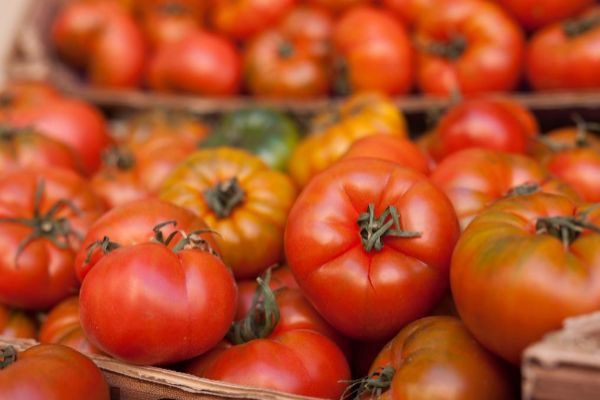- Where to eat the best gazpacho
- Where to eat the best sardines this summer
Its time is coming: end of August, September. The time of the tomato, the real tomato left the earth and not a plastic tent, matured in the sun and sometimes found in the bush itself to its perfect point. The tomato, that fruit -fruit, let's not forget- that Spain brought to Europe from America (and maybe now someone tells us that we have to apologize for it, which is what is fashionable) is recovering its place, its diversity its intense flavor after the sad years of tasteless tomatoes that in Spain - and in many other places - we live from the 70s.
The tomato that did not know anything was born from the investigations to get them of long shelf life , LSL, or long shelf life, which allowed to have in the supermarkets red and bright tomatoes for a week or more. They got it with the first transgenic tomatoes, and it was celebrated as a great achievement. Yes, the flavor was lost along the way , but it was much more profitable. And the consumer paid it.
Curiously, the taste returned from the hand of another investigation, about tomatoes suitable for cultivation in the vast greenhouses of Almeria : by selection and classic crosses - that is, without genetic manipulation - of good traditional tomatoes such as the Alicante almond, the famous raf, which means resistant to fusarium, a fungus that deteriorates those grown under plastic. Like the honey and others, it is of the Marmande type (derived from the tomato obtained in the mid-19th century by hybridization by a horticulturist from Marmande, in the south of France, and which has spread throughout the world), with deep grooves, and over Everything turned out frankly tasty.
So for a few years we had tasty tomatoes ... out of season, and obviously more expensive, because in summer the insipid LSLs returned. Soon we had raf all year, and that seems to have encouraged the producers of good traditional varieties, which are already returning to the shelves, and when they are local, even matured in the plant.
The tomato, in salad, sauce or stew, is a passion in most Spanish homes. Of course, restaurants with an excellent quality of tomato can be recommended, often from their own family garden, or very close. To mention two that reach the genuinely celestial: Angelita (Reina, 4, tel. 91 521 66 78, Madrid) and Estrella de Bajo Carrión (Mayor, 32, tel. 979 82 70 05, Villoldo, Palencia). But the gastronomic, in a matter of tomatoes, is especially prone to find the best and take them to his kitchen.
In many cases the best mean those of regional varieties: the law of freshness is imposed, and also the pleasure of the diversity of styles: more aromatic, more tasty, more or less tight ... and let's say its colors, than a Fully ripe tomato can be green, in addition to red, black, orange, yellow, purple ...
Following some of the clues on which one of the best scientists (and horticulturists) specialized in tomatoes in Spain, Navarrese José Uranga , has written, we can point out, from the south to the north of the country, some of the points where to stock up on the tastiest regional varieties.
The south is historic: the first tomatoes entered Europe five centuries ago. In the Cooperativa La Verde de Villamartín (Cádiz) they cultivate more than 100 types, and the most successful are the coronil, the Algeciras dish and the Segureño black, who never reach us in Madrid - or at least, this chronicler has not found- and they will give us some salads and some great cold soups.
In Coín (Málaga), the Hevilla Family (tel. 676 472 987) and its production excite both Uranga and our partner (and nevertheless friend) José Carlos Capel , who highlight his (suggestive!) Bull egg, « that ripens in red, slightly armored, fleshy, with few seeds and weighing from 300 to 600 grams »and its Coín green.
In the Valencian Community, Punt de Sabor , by Jesús Sanchis, specializes in masclet tomatoes, Castellón rose and the famous Muchamiel. They have two stores (tel. 610 50 97 10) and also sell 'online' (PuntdeSabor.com).
Penjar (hanging) tomatoes are a great Catalan specialty: they are used for the glorious pa amb tomàquet. A very prominent horticulturist is Quino Ortí, from Cardedeu (Barcelona), who sells his products in the Granollers market: look for his cor de bou or beef heart.
In the Bajo Ebro of Tarragona, in Camarles, L'Horta de Carme (tel. 666 231 130) is a completely familiar orchard where the ox heart also shines.
Between Aragon and Navarra they share fraternally the two famous varieties, the Aragonese Barbastro rose and the ugly one from Tudela navarro (whom they call tomato in La Rioja). You know: large, rather pale, powerful ugly and more delicate pink. The La Sazón Cooperative stands out, from Huesca (tel. 670 252 690), and in Navarra the Viveros Sola, by Jesús and Antonio Sola (tel. 677 40 86 05).
In Vizcaya, discover the tomato pikoluze that Alejandro Arrieta cultivates in Markina-Xemein (tel. 665 743 205); in Galicia, the Xebre Collective , from Coruña, cultivates its black from Santiago in Bergantiño; and in Piñel de Abajo (Valladolid), Eduardo Perote cultivates 700 varieties! over 3,000 square meters (tel. 633 08 59 81), and supplies to restaurants and shops across the country, so the chances of finding your tomatoes in big cities are not bad.
Take advantage!
According to the criteria of The Trust Project
Know more- The Gourmet
Gastronomic in summer Why hunting is also for summer
The gastronomic Where to eat the best sardines this summer
Summer gastronomic Where to eat the best gazpacho this summer

